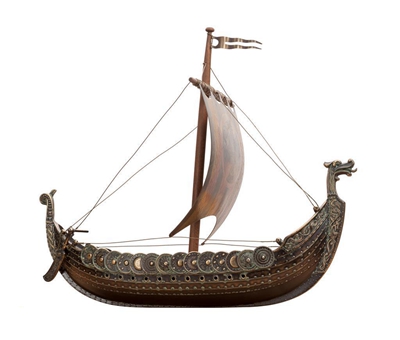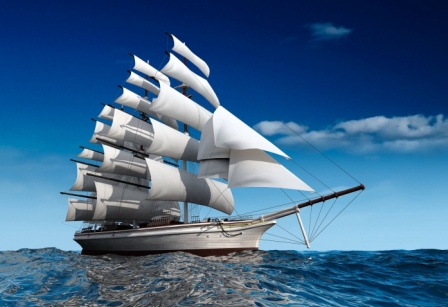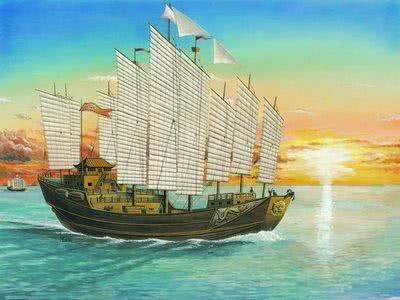Sailing Age
According to records, as early as four thousand years BC, ancient Egypt had sailing ships. The history of China's use of sailing boats can also be traced back to before AD. From the 15th century to the mid-19th century, it was the heyday of sailing development. At the beginning of the 15th century, the Chinese navigator Zheng He sailed to East Africa. At the end of the 15th century, C. Columbus discovered the New World. Their fleet was composed of sailing ships. In the history of sailing development, the Mediterranean coast, northern Europe and Western Europe and China have all made significant contributions. In the middle of the 19th century, the American flying scissor sailing boat was the last climax in the history of sailing development. Sailboats in different regions have their own characteristics in terms of structure, form and sail gear.
Ancient sailing ship in the Mediterranean
An image of the oldest sailing ship is painted on a pottery unearthed in Egypt from the fourth millennium BC. The front end of the ship is protruding upwards, and there is a small square sail at the front of the ship. This kind of ship can only travel downwind and cannot take advantage of side winds. From 2000 to 1600 BC, the Phoenicians, Cretans and Greeks all sailed on the Mediterranean. The ends of the Cretan sailboats were cocked and the single-masted sails were suspended. This type of ship has been used in the Mediterranean for thousands of years. Sailing boats in ancient Greece and Rome were equipped with oars, and they were only used when entering and leaving ports and dispatching. Ancient Greek sailing ships had high freeboards and good seakeeping. The single mast was hung with square sails. There were huge tail rotors on both sides of the stern, which served as rudders. A small sail is added to the mast extending from the bow to facilitate maneuvering. A spinnaker is added to the sling. Ancient Roman sailboats were improved again, adding front and rear spinnakers, and the maneuverability of the ship was improved.

Ancient sailing ship
Northern and Western Europe Sailing
The Vikings of Northern Europe from the 9th to 11th centuries AD were an outstanding sailing nation in the world at that time, with their tracks as far away as Greenland and North America. They used locally produced oak to build a sailing boat with good seaworthiness. This sailboat is about 30 meters long and 6 meters wide. The shape of the bow and tail is close to symmetrical, with a keel and a bow and a stern post. The shell plates are overlapped and connected with iron nails. The ship has a single mast with a sling, and a square sail, so it can travel in cross winds. The shape of the boat is thin and the seakeeping is better than that of a Mediterranean sailing boat.
In 1492, C. Columbus led the Spanish fleet to the West Indies. The "Santa Maria" he was aboard was a three-masted sailing ship 28 meters long and had a displacement of about 200 tons. In 1497, V.da. Gamma led the Portuguese fleet around the Cape of Good Hope to discover the route to India. From 1519 to 1522, the Spanish fleet led by F. Magellan completed voyages around the world. This series of geographical discoveries greatly stimulated the development of European navigation and shipbuilding. After the 16th century, the displacement of European sailboats gradually increased to 500-600 tons, and the sails became more and more complicated. Three-masted ships became more common and the sail surface continued to increase. A top mast and a top sail were added to the big mast, a bottom sail was installed under the main sail, and a spinnaker was placed on the mast line. The entire space on the ship was full of sails, and the speed was increased. Around 1800, Britain became the largest maritime power after Portugal and Spain. Britain and its colonies have 5,000 sailing ships at sea.

"Santa Maria"
Flying scissor boat
This is a high-speed sail that originated in the United States
ferry. Early flying scissor sailboats can be represented by the "Ann Makin" built in 1833, with a displacement of 493 tons. The flying shear sailboat has a long and slender shape, a sharp and protruding front end, a fast speed and a small tonnage. In the 1840s, Americans used this sailboat to China to trade in tea and opium. Later, the gold rush caused by the discovery of gold mines in the western United States led to the rapid development of flying shear sailboats. The "Great Republic" was built in 1853, with a length of 93 meters, a width of 16.2 meters, a depth of 9.1 meters, a displacement of 3400 tons, a mainmast height of 61 meters, a total sail area of 3,760 square meters, a speed of 12 to 14 nautical miles per hour, across the Atlantic Ocean It only took 13 days to mark the peak of the development of sailing ships. After the 1870s, the sailboat, which was the main means of maritime transportation at that time, was quickly replaced by the new steam engine ship.

Flying scissor boat
Chinese Sailing
Chinese sailing ships also have a history of more than two thousand years. According to the records of "Historical Records • The Book of the First Emperor of Qin", the Qin Dynasty once sent Xu Fu to take thousands of people, including virgins and craftsmen, to go to sea. In "The Records of Foreign Objects in Nanzhou" by Soochow Prefect Wan Zhen during the Three Kingdoms Period, there is a description of the large ships used to visit Cambodia, Vietnam and other places today. The Tang Dynasty had frequent exchanges with Japanese culture. At that time, Chinese sailboats were able to sail sideways against the wind and had good seakeeping. During the period of Tang Zhenguan, it only took 6 days from Wenzhou to Japan; in the future, it would take 3 days to sail from Zhenhai, China to Japan. Significant progress was made in shipbuilding and navigation in the Song Dynasty. At that time, the ships built could carry 500 to 600 people, and they had used the compass to sail as far as the Persian Gulf and the coastal areas of East Africa. The wreckage of a Song Dynasty sea-going ship was unearthed in Quanzhou Bay, Fujian Province in 1974. The hull is thin and has good speed and seakeeping performance. There are 12 watertight adjacent walls inside the ship. The side hull plate is composed of three-layer cedar board, and the structure is strong. The ship is about 35 meters long and has a deadweight of more than 200 tons. In the early Ming Dynasty, Zheng He led a huge fleet on seven voyages between 1405 and 1433 AD, traversing Southeast Asia, the Indian Ocean, and reaching the east coast of Africa. According to records, the "treasure boat" on which Zheng He was riding was 44 feet long, 18 feet wide, and had 12 sails. It was the world's premier sailing boat at that time.
The
structure of Chinese sailboats is different from that of European
sailboats. The ends of European sailing boats are pointed and upturned,
while the ends of Chinese sailing boats are horizontally closed with
wooden boards to form a rectangular box with a flat bottom. The rudder
is located on the center line of the tail, and the tail creates a high
platform in the shape of a building to prevent waves. There are multiple
watertight walls inside the ship, and the structure is solid. The sails
of Chinese sailboats are "hard canopies" reinforced with bamboo poles
horizontally. This balanced sail is easy to operate and can withstand
wind in all directions. In the 15th century, Chinese sailboats were in a
leading position in terms of size and performance. After the 16th
century, European sailing ships gradually surpassed Chinese sailing
ships.

XUFU·s East Travil
Source: Chinese Society of Navigation






